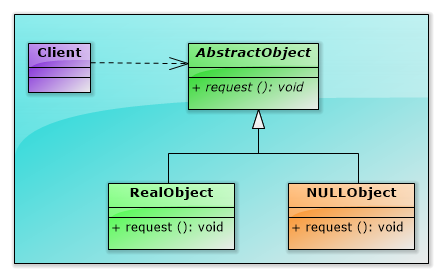空对象模式(Null Object Pattern)
2017-09-27 16:17
246 查看
31.3 空对象模式(Null Object Pattern)
31.3.1 定义和类图
(1)定义:通过实现一个默认的无意义对象来避免NULL值出现。简单地说,就是为了避免在程序中出现NULL值判断而诞生的一种常用设计方法。
(2)类图

31.3.2 应用场景
(1)不使用空对象模式的例子
【编程实验】利用工厂模式创建图书
(2)解决方案:空对象模式
【编程实验】利用工厂模式+空对象模式创建图书
31.3.3 小结
(1)空对象模式可以加强系统的稳固性,能有效防止空指针报错对整个系统的影响。
(2)能够实现对空对象情况的定制化的控制,能够掌握处理空对象的主动权
(3)不依赖Client端来保证整个系统的稳定运行
(4)它通过isNull代替“==NULL”,显得更加优雅,更加易懂。
31.3.1 定义和类图
(1)定义:通过实现一个默认的无意义对象来避免NULL值出现。简单地说,就是为了避免在程序中出现NULL值判断而诞生的一种常用设计方法。
(2)类图

31.3.2 应用场景
(1)不使用空对象模式的例子
【编程实验】利用工厂模式创建图书
//新设计模式——空对象模式
//场景:利用简单工厂方法创建图书(不使用空对象模式)
#include <iostream>
#include <string>
using namespace std;
class IBook
{
public:
//展示Book对象信息内容
virtual void show() = 0;
};
//具体的书
class Book :public IBook
{
private:
int id;
string name;
string author;
public:
//构造函数
Book(int id, string name, string author)
{
this->id = id;
this->name = name;
this->author = author;
}
void show()
{
cout <<"ID = " << id <<", Name = "
<< name << ", Author = " << author <<endl;
}
};
//图书对象的图书工厂代码
class BookFactory
{
public:
IBook* getBook(int id)
{
IBook* book = NULL;
switch(id)
{
case 1:
book = new Book(id, "设计模式", "GOF");
break;
case 2:
book = new Book(id, "编译原理", "Alfred V.Aho");
break;
default:
book = NULL;
break;
}
return book;
}
};
int main()
{
BookFactory bf;
IBook* book = bf.getBook(3); //传入1、2时正常运行,但其他值时会报错。
//常规做法是客户端加一个判断,如果为NULL,就不能调用Show
//但这种做法要依赖客户端,如果是多处调用的话,则每处都必须判断也显得很
//麻烦,如何解决这个问题?见后面的空对象模式
if(book == NULL)
{
cout << "book对象为NULL" << endl;
}
else
{
book->show();
}
return 0;
};(2)解决方案:空对象模式
【编程实验】利用工厂模式+空对象模式创建图书
//新设计模式——空对象模式
//场景:利用简单工厂方法创建图书(使用空对象模式)
#include <iostream>
#include <string>
using namespace std;
class IBook
{
public:
//展示Book对象信息内容
virtual void show() = 0;
//判断对象是否为空
virtual bool isNull() = 0; //注意,这是新增的方法
};
//具体的书
class Book :public IBook
{
private:
int id;
string name;
string author;
public:
//构造函数
Book(int id, string name, string author)
{
this->id = id;
this->name = name;
this->author = author;
}
void show()
{
cout <<"ID = " << id <<", Name = "
<< name << ", Author = " << author <<endl;
}
bool isNull()
{
return false; //返回false
}
};
//新增的空对象类(继承自IBook)
class NullBook : public IBook
{
public:
//show
void show()
{
//提示出错信息,一处定制,处处使用,主动权掌握在我们手里,而不是客户端手里
cout <<"Sorry,未找到符合您输入的ID的图书信息,请确认您输入的不是非法值。" << endl;
}
bool isNull()
{
return true; //这里返回true
}
};
//图书对象的图书工厂代码
class BookFactory
{
public:
IBook* getBook(int id)
{
IBook* book = NULL;
switch(id)
{
case 1:
book = new Book(id, "设计模式", "GOF");
break;
case 2:
book = new Book(id, "编译原理", "Alfred V.Aho");
break;
default:
book = new NullBook(); //创建一个NullBook对象
break;
}
return book;
}
};
int main()
{
BookFactory bf;
IBook* book = bf.getBook(3); //传入1、2时正常运行,但其他值时返回空对象。
//由于返回的book永远不等于NULL,这里可以直接调用book->show()
//book->show();
//但也可以让客户端调用isNull函数,并定制客户端自己的错误提示
if(book->isNull())
{
//这里由客户端定制提示信息
cout << "兄弟,你输入的ID不符合规范吧?" << endl;
}
else
{
book->show();
}
return 0;
};31.3.3 小结
(1)空对象模式可以加强系统的稳固性,能有效防止空指针报错对整个系统的影响。
(2)能够实现对空对象情况的定制化的控制,能够掌握处理空对象的主动权
(3)不依赖Client端来保证整个系统的稳定运行
(4)它通过isNull代替“==NULL”,显得更加优雅,更加易懂。
相关文章推荐
- Java Null Object Pattern(空对象模式)
- 设计模式:空对象模式(Null Object Pattern)
- 空对象模式(Null Object Pattern)
- 被遗忘的设计模式——空对象模式(Null Object Pattern)
- Java 空对象设计模式(Null Object Pattern) 讲解
- C#对象为Null模式(Null Object Pattern)实例教程
- 被遗忘的设计模式——空对象模式(Null Object Pattern)
- 用最简单的例子理解对象为Null模式(Null Object Pattern)
- 被遗忘的设计模式——空对象模式(Null Object Pattern)
- 【设计模式】空对象模式(Null Object Pattern)
- Java 空对象设计模式(Null Object Pattern) 讲解
- 设计模式:空对象模式(Null Object Pattern)
- 设计模式:空对象模式(Null Object Pattern)
- 适配器模式(Adapter Pattern 类对象结构型模式)
- 协调多个对象之间的交互——中介者模式(Mediator Pattern)
- 设计模式学习—传输对象模式(Transfer Object Design Pattern)
- 创建模式(Builder Pattern、构建模式、生成器,对象创建型模式)
- 面向对象设计模式之---简易工厂模式(Simple Factory Pattern)
- 简单工厂模式(Simple Factory Pattern(静态工厂方法模式)对象创建型模式)
- 【设计模式 - 21】之空对象模式(Null Object)
